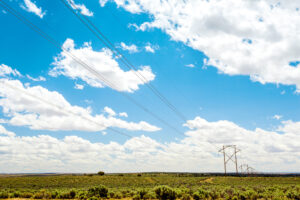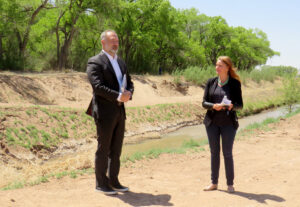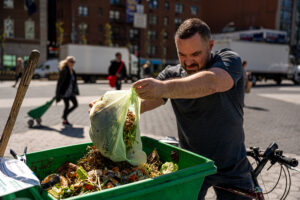Groups work to track E. coli in rivers

In late August, San Juan Watershed Group Coordinator Alyssa Richmond reached out across the San Juan River using a long pole as it flowed through the Fruitland area and scooped up water. This water was transferred into a bottle that was capped to be sent to a lab in Florida where it will be analyzed to see how much bacteria like E. coli is coming from human waste.
Human waste can lead to high levels of E. coli in rivers and the section of the San Juan River where the watershed group collected samples is listed as impaired for the bacteria. That means if people were to ingest the raw water it could make them sick.
E. coli is one of the top three causes of water impairment in New Mexico, according to the New Mexico Environment Department’s 2020-2022 integrated report, and agencies throughout the state are working to address the bacteria contamination.
E. coli in the water can come from numerous sources, including leaking septic tanks, livestock, wildlife and pets.
Efforts are underway on both the San Juan River in northwest New Mexico and the Rio Grande in Albuquerque to test how much E. coli is coming from human waste. Both of the studies are being done to follow up on previous testing.
A 2005 study on the Rio Grande found birds were the largest source of the bacteria, followed by canines, according to Kali Bronson, stormwater program compliance manager for Bernalillo County’s Natural Resource Services. Humans were the third leading source of E. coli. Meanwhile, on the San Juan River, livestock and birds contribute more to the E. coli levels than human waste.
But humans are still a significant source of E. coli and, Richmond said, the results of a 2013 and 2014 sampling effort on the San Juan River showed surprising levels of bacteria related to human fecal waste.
San Juan River
During the past study, 94 percent of the samples taken came back positive for human waste. Additionally, 46 percent of the samples exceeded the standards for swimming. The greatest concentration of E. coli contamination was found in the stretch of river between Farmington and Hogback, where the sampling efforts ended. Hogback marks the boundary with Navajo Nation and the end of the jurisdiction of the San Juan Soil & Water Conservation District, which oversees the watershed group.
Following the 2013 and 2014 study, there was an increased focus on addressing fecal waste. This helped efforts like getting a subdivision in Kirtland hooked up to municipal sewer.
But then the Gold King Mine spill happened.
“It was oftentimes, and rightfully so, a distraction,” Richmond said.
Now, six years after the mine spill, the watershed group is once again focused on the bacteria in the river.
The San Juan Watershed Group received funding from the U.S. Environmental Protection Agency’s Clean Water Act Section 604 program, which is administered by the New Mexico Environment Department, to conduct the current sampling study.
Kaitlyn O’Brien, a NMED spokesperson, said in an email that there are efforts underway throughout the state to address E. coli in the water, but the San Juan Watershed Group is the only one in the state funded through the 604 program to do that type of microbial source tracking.
Sampling began in early August and will continue through October at 17 locations along the San Juan River. Sampling takes two days. On the first day, samples are collected by people floating down the river on rafts. On the second day, the group drives to locations to take samples. In addition to focusing on the main stream of the San Juan River, samples are taken at tributaries such as the La Plata River and in the backwaters of irrigation ditches near the confluence with the river. This will help determine where the E. coli is entering the river.
“This type of water quality data has not been collected at this scale on the San Juan,” Richmond said.
While the sampling is still going on, Richmond said the initial results from the first round of sampling “were pretty bad” with some samples containing about three times more E. coli than would naturally be expected in the river.
Rio Grande
In 2019, Bernalillo County approached the U.S. Geological Survey about partnering to sample a stretch of the Rio Grande for E. coli. The samples are sent to the USGS Ohio Water Science Center to determine the source of the E. coli, for example if it came from humans, dogs or wildlife. While some sampling was done in 2019, the study really got underway in 2020, she said.
Rebecca Travis, a hydrologist with the U.S. Geological Survey, said there are a total of five sample locations on the Rio Grande from Bridge Boulevard to Valle de Oro and samples are taken six times each year, giving a total of 12 data points per site.
This is being done during the dry months when E. coli levels are higher. Doing the sampling during the dry season means that stormwater won’t be contributing as much to the E. coli levels. However, Travis said there has been some sampling done following storms “for comparability’s sake.”
The sampling efforts are wrapping up this month and Travis anticipates that a report will be finalized and given to Bernalillo County in the fall of 2022.
“It will just be an interesting study to see what comes out of it,” Travis said. “It will probably give us a snapshot of the picture, but there’s always more that we could learn from additional studies and research in the area.”
Bronson said the permit to discharge stormwater requires Bernalillo County and other entities in the area to manage for E. coli and to work to address water quality issues.
Following the 2005 study, which was led by Albuquerque, officials have undertaken various efforts to reduce the bacteria.
For example, people walking their dogs and not picking up after them have had an impact on the E. coli in the Rio Grande, leading to efforts to educate people. This can be seen in the increasingly common “there is no poop fairy” signs.
Bronson said this not only helps the river but makes it more enjoyable for people out recreating, adding that people don’t want to step in dog poop.
The sampling could show if those efforts have made a difference.
“It would be great to see a reduction in it,” Bronson said.
However, she said during COVID-19 people have been recreating more with their pets and the county has received more complaints about dog waste in the last year than they have had previously.
Bronson said that could be because more people are out there noticing the dog waste or it could be because there has been an increase in dog waste left in public areas.
Even if the location is far from the river, storm water can carry the pet waste down into the Rio Grande, Bronson said.
Additionally, Bernalillo County has programs to make sure septic systems are up to code and to educate people about proper maintenance. While the metro areas like Albuquerque have municipal wastewater systems, or sewers, many unincorporated areas rely on septic tanks, Bronson said.
“There really are quite a bit more septic systems than people are probably aware,” she said.
Having the data from the river sampling can help as entities seek grant and other funding opportunities to address the bacterial contamination, Bronson said. Additionally, she said it will help focus the efforts.
Other efforts to address E. coli
O’Brien said NMED is working with various entities around the state to reduce E. coli in the surface water. She gave a list of examples including partnering with organizations like New Mexico State University and Hermit’s Peak Watershed Alliance to implement management measures such as education and outreach to reduce E. coli contamination in Rincon Arroyo and the Upper Mora River.
NMED has also allocated state River Stewardship funding to the City of Santa Fe to implement management measures on the Santa Fe River intended to reduce E. coli levels.
And, in the Rio Fernando de Taos watershed, she said the nonprofit Amigos Bravos is working using Clean Water Act funding to install portable bathrooms and pet waste stations.
This article was originally posted on Groups work to track E. coli in rivers







